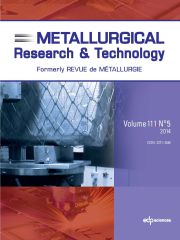Crossref Citations
This article has been cited by the following publications. This list is generated based on data provided by
Crossref.
He, Zhanwei
Liu, Jianxing
Yang, Songtao
Yang, He
and
Xue, Xiangxin
2016.
Partition of valuable components between slag and metal in the blast furnace operating with high chromium, vanadium, titanium, magnetite ores.
Metallurgical Research & Technology,
Vol. 113,
Issue. 6,
p.
607.
Torabi, Seyyed Amin
Amini, Kamran
and
Gharavi, Farhad
2017.
The effect of shot peening and precipitation hardening on the wear behavior of high manganese austenitic steels.
Metallurgical Research & Technology,
Vol. 114,
Issue. 5,
p.
507.
Sabzi, M.
Obeydavi, A.
and
Mousavi Anijdan, S. H.
2019.
The effect of joint shape geometry on the microstructural evolution, fracture toughness, and corrosion behavior of the welded joints of a Hadfield Steel.
Mechanics of Advanced Materials and Structures,
Vol. 26,
Issue. 12,
p.
1053.
Juez-Gil, Mario
Erdakov, Ivan Nikolaevich
Bustillo, Andres
and
Pimenov, Danil Yurievich
2019.
A regression-tree multilayer-perceptron hybrid strategy for the prediction of ore crushing-plate lifetimes.
Journal of Advanced Research,
Vol. 18,
Issue. ,
p.
173.
Fernandes, Pablo Enrique Guzman
and
Santos, Leandro Arruda
2020.
Effect of titanium and nitrogen inoculation on the microstructure, mechanical properties and abrasive wear resistance of Hadfield Steels.
REM - International Engineering Journal,
Vol. 73,
Issue. 1,
p.
77.
Amini, Kamran
2021.
The Effect of Silicon Percentage and Shot Peening Operation on Mechanical Properties of Hadfield Steel Containing 17% Manganese.
Protection of Metals and Physical Chemistry of Surfaces,
Vol. 57,
Issue. 3,
p.
589.
Gürol, Uğur
Karadeniz, Erdal
Çoban, Ozan
and
Kurnaz, Süleyman Can
2021.
Casting properties of ASTM A128 Gr. E1 steel modified with Mn-alloying and titanium ladle treatment.
China Foundry,
Vol. 18,
Issue. 3,
p.
199.
Dziubek, Mateusz
Rutkowska-Gorczyca, Małgorzata
Dudziński, Włodzimierz
and
Grygier, Dominika
2022.
Investigation into Changes of Microstructure and Abrasive Wear Resistance Occurring in High Manganese Steel X120Mn12 during Isothermal Annealing and Re-Austenitisation Process.
Materials,
Vol. 15,
Issue. 7,
p.
2622.
Dziubek, Mateusz
Rutkowska-Gorczyca, Małgorzata
and
Grygier, Dominika
2023.
The effect of the austenitisation temperaturefor the two-stage heat treatment of high-manganesesteels on its wear resistance under abrasiveconditions.
Tribologia,
Vol. 305,
Issue. 3,
p.
19.
Arapov, S. L.
Belyaev, S. V.
Kosovich, A. A.
Partyko, E. G.
Stepanenko, N. A.
Yuriev, P. O.
and
Mansurov, Y. N.
2023.
Application of Mathematical Statistics to Improve Hadfield Steel Casting Impact Strength.
Metallurgist,
Vol. 66,
Issue. 9-10,
p.
1083.
Karanam, Abhinav
Sarkar, Arnab
Nenzen, Erik
Athavale, Viraj Ashok
Watson, Mark
Bartlett, Laura Nicole
and
Bichler, Lukas
2024.
Microstructure Evolution and Austenitic Grain Refinement of Ti-Modified High Mn Steels During Solution Annealing Heat Treatment.
Metallurgical and Materials Transactions A,
Vol. 55,
Issue. 2,
p.
389.
Altuntaş, Gözde
Altuntaş, Onur
and
Bostan, Bülent
2024.
Evaluation of the Effect of Shallow Cryogenic Treatment on Tribological Properties and Microstructure of High Manganese Steel.
International Journal of Metalcasting,
Vol. 18,
Issue. 2,
p.
1523.
Zemlik, Martyna
Konat, Łukasz
Leśny, Kacper
and
Jamroziak, Krzysztof
2024.
Comparison of Abrasive Wear Resistance of Hardox Steel and Hadfield Cast Steel.
Applied Sciences,
Vol. 14,
Issue. 23,
p.
11141.
Li, Jiaxin
Wang, Xiang
Cheng, Minghui
and
Ma, Xuliang
2025.
Progress in the preparation method and mechanical properties of TiC particle-reinforced steel matrix composites.
Materials Today Communications,
Vol. 42,
Issue. ,
p.
111311.
Luo, Yifeng
Li, Ke
Wei, Zijia
Chen, Bowen
Hou, Yao
Wang, Yang
Cui, Shuxun
Ni, Jing
Wang, Jindong
and
Cai, Zhenbing
2025.
Effect of milling on fretting wear performance of GH4169 superalloy.
Materials Today Communications,
Vol. 44,
Issue. ,
p.
111845.
Karanam, Abhinav
Pillari, Lava Kumar
Kennedy, Ashton
Li, Delin
and
Bichler, Lukas
2025.
Enhancing wear performance: the role of in situ TiC formation in austenitic high-Mn steel under dry reciprocating wear conditions.
Journal of Materials Science,
Vol. 60,
Issue. 25,
p.
10527.

